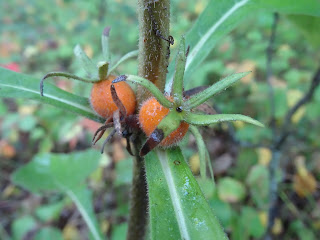White Goldenrod (Solidago bicolor), also known as Silver-rod due to it's spike of white (not yellow) flowers is somewhat restricted in Ontario to sandy forests along the north shore of Lake Erie and Ontario. I found a new population near Pembroke a few years back but a map produced by Semple shows an arm reaching up from New York, so not that surprising. Unlike some of our other more common goldenrods, this species 'behaves' with plants occurring more or less individually throughout the forest floor.
Exploring some sand blowout areas I found plenty of Round-headed Bush-clover (Lespedeza capitata).
Orange-fruited Horse Gentian (Triosteum aurantiacum) has seeds which look just like coffee beans.
They don't make common plant names short...this is Fern-leaved False Foxglove (Aureolaria pedicularia). A species of sandy woodlands and savannahs. This species, along with 2 other species in the genus which occur in Ontario, is currently being evaluated by COSEWIC and will likely become listed as Threatened or Endangered.
 |
| Intermediate Pinweed (Lechea intermedia) |
Other rarities like Virginia Goats-rue (Tephrosia virginiana) can be found in high quality woodland and savannah. Some recent trips to Wisconsin and Illinois have shown that this species is much more common to the southwest, but is still rare throughout much of it's range.
 |
| Whorled Loosestrife (Lysimachia quadrifolia) |
 |
| A good way to end the day! |
















